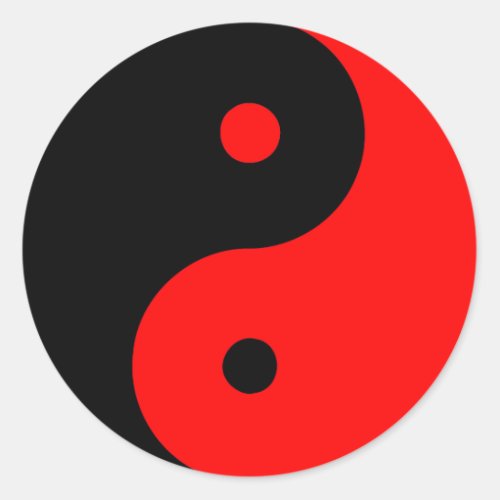Yin Yang Ying Taoism Sign Chinese Taijitu Red Classic Round Sticker



In Chinese philosophy, the concept of yin yang eum-yang in Korean; often referred to in the west as yin and yang) is used to describe how seemingly disjunct or opposing forces are interconnected and interdependent in the natural world, giving rise to each other in turn. The concept lies at the heart of many branches of classical Chinese science and philosophy, as well as being a primary guideline of traditional Chinese medicine, and a central principle of different forms of Chinese martial arts and exercise, such as baguazhang, taijiquan, and qigong. Many natural dualities – e.g. dark and light, female and male, low and high – are cast in Chinese thought as yin yang. Some call it ying and yang but this is not correct. According to the philosophy, yin and yang are complementary opposites within a greater whole. Everything has both yin and yang aspects, which constantly interact, never existing in absolute stasis. Compare wuji. Yin and yang is symbolized by various forms of the Taijitu. Yin and yang are thought to arise together from an initial quiescence or emptiness (wuji, sometimes symbolized by an empty circle), and to continue moving in tandem until quiescence is reached again. For instance, dropping a stone in a calm pool of water will simultaneously raise waves and lower troughs between them, and this alternation of high and low points in the water will radiate outward until the movement dissipates and the pool is calm once more. Yin–yang, thus, always has the following characteristic: yin and yang describe opposing qualities in phenomena. For instance, winter is yin to summer's yang over the course of a year, and femininity is yin to masculinity's yang in human relationships. The relationship between yin and yang is often described in terms of sunlight playing over a mountain and in the valley. Yin (literally the 'shady place' or 'north slope') is the dark area occluded by the mountain's bulk, while yang (literally the 'sunny place' or 'south slope') is the brightly lit portion. As the sun moves across the sky, yin and yang gradually trade places with each other, revealing what was obscured and obscuring what was revealed. Yin is usually characterized as slow, soft, insubstantial, diffuse, cold, wet, and tranquil. It is generally associated with the feminine, birth and generation, and with the night. Yang, by contrast, is characterized as hard, fast, solid, dry, focused, hot, and aggressive. It is associated with masculinity and daytime. Yang is associated with day, mountains, hills, fire, wood, and air. The concept of "unity in duality" arises in many faiths and philosophies, from the philosophy of Heraclitus, to the nondualistic philosophies of Hinduism, Sikhism, Taoism, and Buddhism, to Gnosticism, Zoroastrianism and New Thought. Yin–yang is unique, however, both in its dynamic nature and its broad application to the natural world. Tàijítú is a term which refers to any of the Chinese symbols for the concept of yin and yang (Taiji), and is sometimes extended to similar geometric patterns used historically by various cultures. The most recognized form is composed of two semi-circular teardrop-shaped curves of different colors, or a circle separated by an S-shaped line, where each half is marked with a dot in a differing color. The two color choices are traditionally black and white. Symbols of this type are found as Celtic art forms and coat of arms for several Western Roman army units in Late Antiquity. Taoist philosophy adopted equivalent symbols several hundred years later, as representations of yin and yang, from which the most common modern usage of the symbol and the name 'taijitu' arise. There is no academically established relationship between the Taoist and the earlier ancient Roman symbols. Symbols with a partial resemblance to the later Taoist diagram appeared in Celtic art from the 3rd century BC onwards, showing groups of leaves separated by an S-shaped line. The pattern lacked the element of mutual penetration, though, and the two halfs were not always portraited in different colours. A mosaic in a Roman villa in Sousse, Tunisia, features different colors for the two halves of the circle, but here, too, the little circles of opposite color are absent.


